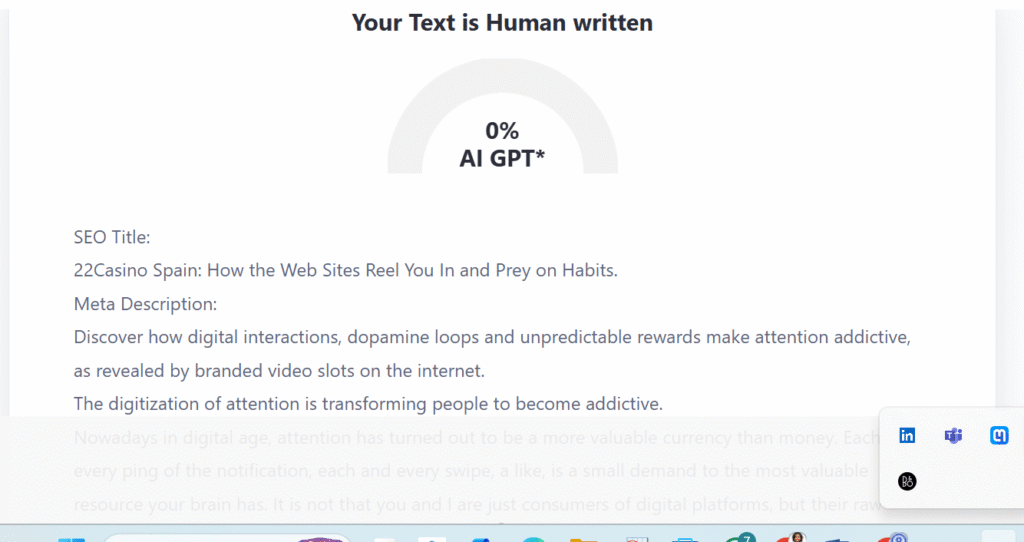
In the digital age, attention has become a more valuable currency than money. Every ping of the notification, every swipe, a like, is a small demand on the most valuable resource your brain has. It is not that you and I are just consumers of digital platforms, but their raw material. And as with any asset, our attention can be mined, molded, and, indeed, addicted.
Attention Economy and Its Trapping Pits.
Digital platforms are built on engagement. The farther you scroll, the more advertisements you are shown, and the more data you produce — it is a precision attention economy. What might seem like idle window shopping is actually a deliberately crafted experience designed to capture — and maintain — your attention. This is no coincidence; it is mass behavioral engineering.
The effect of the platforms is playing upon the same psychological triggers to which casinos have historically appealed: anticipation, immediate satisfaction and the slight sense of uncertainty. Consider the digitalization of variable rewards in a slot machine. Each ping of a new message or a video being recommended is a micro-dopamine release, which supports the habit loop and encourages you to get one rounder. This can be seen even in non-gambling contexts, where a compulsive attraction to branded video slots online, such as those found at 22Casino Spain, is evident. Variable pay structures and visual stimulation keep players coming back.
Decision Fatigue and Dopamine Loops.
The dopamine loop is the center of digital addiction. Dopamine is not the “feel-good” chemical–it is the pay attention and repeat chemical. Each new alarm or unexpected reward triggers a burst of activity, conditioning the brain to seek the next.
But the brain isn’t infinite. Being connected all the time is a stress on our executive capacity, which causes decision fatigue. We begin scrolling, clicking, or tapping without thinking, often without considering the logical consequences. This mental trap is a bias in our minds, where we prefer immediate gratification over long-term gratification, and this seemingly harmless act of just surfing the web has become compulsive.
Simply, what we are doing is training our brains to react like a trained gambler to patterns of the game. Here, it is the feed that makes the game, and the likes, streak, and notifications make the wins.
Online Behavior.
The dynamics of interactions are ubiquitous. The infinite scroll is a feature on social media platforms designed to encourage prolonged scrolling. Video streaming platforms automatically follow up with the next episode, capitalizing on our inherent desire for continuity and the comfort of uninterrupted viewing. To capture user attention, mobile apps often utilize gamification, which includes streaks and badges, as well as micro-rewards offered on a daily basis.
And, although this is not direct gambling, the similarities to branded video slots online at 22Casino Spain are vivid even beyond the direct gambling. Both depend on such visual and auditory signals, as well as intermittent reinforcement and the expectation of reward. The contrast lies in scale: digital platforms can run these systems in continuous mode and enhance their learning approach by observing each user’s actions and adjusting behaviour patterns in real-time.
Neuroscience: Behind the Hook.
The repetition alters the brain. This is guaranteed by neuroplasticity, which creates neural networks that reinforce behaviors, making them habitual and progressively harder to disengage from. The executive part of the brain, which enables one to maintain control over oneself, is gradually overwhelmed by the temptation of quick gratification.
Behavioral economists highlight the use of these cognitive shortcuts to enhance digital engagement. The worst type of rewards are variable rewards, which have been borrowed from the psychology of gambling. They leave us wondering and rolling dice as a slot machine teases us with unknown wins. The computer space merely provides additional cues, additional data, and additional feedback loops to enhance the effect.
Implications to Society and the Individual.
Attention addiction has far-reaching effects. On a personal level, being constantly connected can cause one to lose concentration, disrupt sleep patterns, and make one feel as though they are in a constant state of hurry. Economically, it benefits the monetizers of attention, whether through advertisements, in-app purchases, or online gaming.
To people accustomed to gambling settings, knowledge of such mechanisms is readily apparent. The same science that makes your phone difficult to put down makes slot machines so very interesting. The same principle is being applied, as digital platforms utilize behavioural design to keep users spending hours on them. The contrast is so slight, yet significant: in this case, the reward does not consist of cash, but rather attention, which is converted into money elsewhere.
